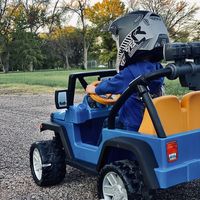
When it comes to choosing ride-on toys for your child, the options can be overwhelming. Two popular categories are Power Wheels and traditional ride-on toys. Each type has its advantages and disadvantages, and understanding these differences can help you make an informed decision. This article will explore the features, benefits, and drawbacks of both Power Wheels and traditional ride-on toys, ultimately helping you determine which is the best choice for your little one.
What Are Power Wheels?
Power Wheels are battery-powered ride-on vehicles designed for young children. They come in various styles, mimicking real cars, trucks, and even ATVs. Typically equipped with features like working headlights, realistic sounds, and sometimes even Bluetooth connectivity, Power Wheels offer an immersive driving experience.
Features of Power Wheels
- Battery-Powered: Most Power Wheels operate on rechargeable batteries, allowing for hours of fun without the need for pushing or pedaling.
- Speed Options: Many models come with adjustable speed settings, allowing parents to control how fast their child can go.
- Realistic Designs: Power Wheels often replicate real-life vehicles, making them exciting for kids who dream of driving.
- Safety Features: Most models include features like seat belts, automatic brakes, and durable construction to ensure safety.
Benefits of Power Wheels
- Convenience: Power Wheels can be driven with minimal effort, allowing younger children to enjoy the experience without requiring parental assistance.
- Realistic Play: The realistic designs and features encourage imaginative play, helping children engage with their environment.
- Longer Playtime: With a full charge, kids can enjoy hours of riding, making it a great option for outdoor playdates.
Drawbacks of Power Wheels
- Price: Power Wheels can be significantly more expensive than traditional ride-on toys, which may be a consideration for budget-conscious parents.
- Limited Terrain: While some models are designed for off-road use, most Power Wheels are best suited for flat surfaces, limiting where they can be ridden.
- Maintenance: Battery-operated vehicles require regular maintenance, including charging and potential battery replacement, which can be inconvenient.
What Are Traditional Ride-On Toys?
Traditional ride-on toys include a wide range of products, such as tricycles, scooters, and push cars. These toys typically require children to pedal, push, or scoot themselves along. They come in various designs, from simple wooden models to more complex plastic designs.
Features of Traditional Ride-On Toys
- Pedal Power: Many traditional ride-on toys require kids to pedal or push themselves along, providing exercise and promoting physical activity.
- Variety: There are numerous styles and types available, catering to different age groups and interests.
- Durability: Many traditional ride-on toys are made from sturdy materials like wood or heavy-duty plastic, ensuring they can withstand rough play.
- No Batteries Required: These toys don’t need batteries, which means no charging or maintenance is necessary.
Benefits of Traditional Ride-On Toys
- Physical Activity: Traditional ride-on toys encourage children to engage in physical play, which is essential for their development and health.
- Affordability: Generally, these toys are more affordable than Power Wheels, making them accessible to a broader range of families.
- Versatility: Many traditional ride-on toys can be used on various terrains, including sidewalks, driveways, and parks.
Drawbacks of Traditional Ride-On Toys
- Effort Required: Children need to exert energy to propel themselves, which can be a downside for those who prefer a more relaxed riding experience.
- Limited Features: Compared to Power Wheels, traditional ride-on toys often lack the exciting features that enhance imaginative play.
- Age Limitations: Some models may not be suitable for older children, as they may outgrow the toy quickly.
Comparing Power Wheels and Traditional Ride-On Toys
Age Appropriateness
- Power Wheels: Typically suitable for children aged 3-7 years, Power Wheels often have weight limits that may restrict older or larger children from using them.
- Traditional Ride-On Toys: These toys can be found for a wider range of ages, from infants in push cars to older children on bikes or scooters.
Safety Considerations
- Power Wheels: Most models come with safety features, but parents should supervise play to ensure safe operation, especially when driving at higher speeds.
- Traditional Ride-On Toys: While generally safe, parents should still monitor their children, especially if they are riding in areas with traffic or uneven terrain.
Ease of Use
- Power Wheels: These toys require little physical effort, making them accessible for younger children who may struggle with pedaling.
- Traditional Ride-On Toys: These often require more physical effort, which can help develop strength and coordination but may be challenging for some children.
Storage and Portability
- Power Wheels: Due to their size and battery components, Power Wheels can be cumbersome to store and transport.
- Traditional Ride-On Toys: Many models are smaller and lighter, making them easier to store and carry.
Making the Right Choice for Your Child
When deciding between Power Wheels and traditional ride-on toys, consider the following factors:
- Your Child’s Age and Size: Ensure the toy is appropriate for your child’s age and weight.
- Physical Activity Level: If you want to encourage exercise, traditional ride-on toys may be the better option.
- Budget: Consider your budget and the long-term costs associated with battery maintenance for Power Wheels.
- Play Environment: Think about where your child will be riding. If you have a flat, spacious area, Power Wheels might work well. If you’re in a smaller space, traditional ride-on toys may be more suitable.
Conclusion
Ultimately, the choice between Power Wheels and traditional ride-on toys depends on your child’s preferences, your budget, and your family’s lifestyle. Power Wheels offer a thrilling driving experience with various features, while traditional ride-on toys encourage physical activity and imaginative play. By weighing the pros and cons of each option, you can select the best ride-on toy that will provide joy and excitement for your child for years to come.
No matter which you choose, both types of toys can create cherished memories and foster development as your child grows. Happy riding!
For More : https://coknews.com/